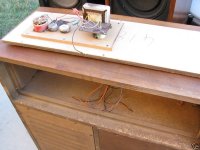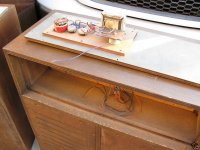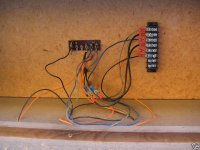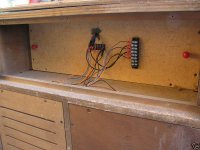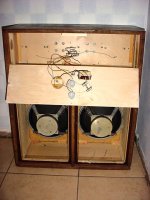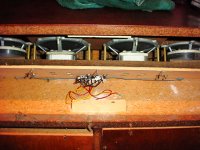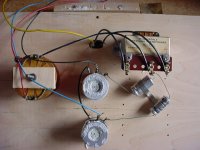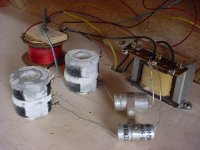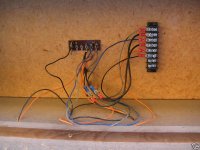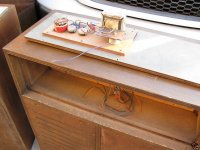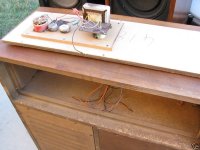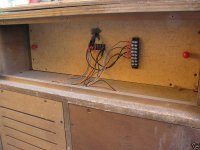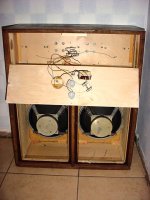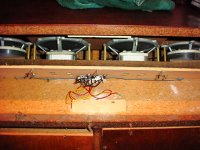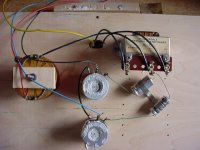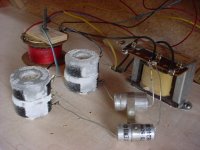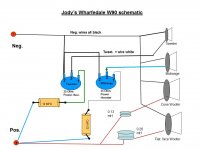Hi,
I have a pair of Wharfedale W90 speakers (sand-filled model).
I'm desperately looking for someone who has a photograph of the crossover
for these, or some know-how of the configuration.
I've been attempting to repair them for a year and have had some techs playing around with bypassing the crossover (didn't work).
Any help would be greatly appreciated, as I've almost given up. Wharfedale informed me that they lost this information when one of their facilities burnt several years ago.
Finding someone with some know-how is my only hope.
Kind thanks
I have a pair of Wharfedale W90 speakers (sand-filled model).
I'm desperately looking for someone who has a photograph of the crossover
for these, or some know-how of the configuration.
I've been attempting to repair them for a year and have had some techs playing around with bypassing the crossover (didn't work).
Any help would be greatly appreciated, as I've almost given up. Wharfedale informed me that they lost this information when one of their facilities burnt several years ago.
Finding someone with some know-how is my only hope.
Kind thanks
I hope these help you, Jody. I didn't take the piccies; found them on the net quite a long time ago. I'm one of those vintage Wharfedale nuts; it dates back to when I was 15. That was in 1957.
Your mentioning that 'some techs tried bypassing the crossover'. I hope they substituted another in its place as even if the tweeters weren't damaged, the system would sound awful assuming a crossoverless setup. I knew a fella back in the 60's who had a pair of these W90's and they do sound good despite what some audio fanatics might say about the way the mids and tweets are configured.
Your mentioning that 'some techs tried bypassing the crossover'. I hope they substituted another in its place as even if the tweeters weren't damaged, the system would sound awful assuming a crossoverless setup. I knew a fella back in the 60's who had a pair of these W90's and they do sound good despite what some audio fanatics might say about the way the mids and tweets are configured.
Hi,
I have a pair of Wharfedale W90 speakers (sand-filled model).
I'm desperately looking for someone who has a photograph of the crossover
for these, or some know-how of the configuration.
I've been attempting to repair them for a year and have had some techs playing around with bypassing the crossover (didn't work).
Any help would be greatly appreciated, as I've almost given up. Wharfedale informed me that they lost this information when one of their facilities burnt several years ago.
Finding someone with some know-how is my only hope.
Kind thanks
Attachments
W90's
I hope these help you, Jody. I didn't take the piccies; found them on the net quite a long time ago. I'm one of those vintage Wharfedale nuts; it dates back to when I was 15. That was in 1957.
Your mentioning that 'some techs tried bypassing the crossover'. I hope they substituted another in its place as even if the tweeters weren't damaged, the system would sound awful assuming a crossoverless setup. I knew a fella back in the 60's who had a pair of these W90's and they do sound good despite what some audio fanatics might say about the way the mids and tweets are configured.
I hope these help you, Jody. I didn't take the piccies; found them on the net quite a long time ago. I'm one of those vintage Wharfedale nuts; it dates back to when I was 15. That was in 1957.
Your mentioning that 'some techs tried bypassing the crossover'. I hope they substituted another in its place as even if the tweeters weren't damaged, the system would sound awful assuming a crossoverless setup. I knew a fella back in the 60's who had a pair of these W90's and they do sound good despite what some audio fanatics might say about the way the mids and tweets are configured.
Hi,
I have a pair of Wharfedale W90 speakers (sand-filled model).
I'm desperately looking for someone who has a photograph of the crossover
for these, or some know-how of the configuration.
I've been attempting to repair them for a year and have had some techs playing around with bypassing the crossover (didn't work).
Any help would be greatly appreciated, as I've almost given up. Wharfedale informed me that they lost this information when one of their facilities burnt several years ago.
Finding someone with some know-how is my only hope.
Kind thanks
Attachments
My apologies for any confusion regarding the photos. I noticed that difference at the time I uploaded the pix but paid little attention to any possible confusion. The W90's had many revisions over the years. I believe the original W90 was available in 1064 as the W90. In subsequent years, there was the suffix "a through d" added to identify modifications. So, now we have 5 variations. These variations probably included the crossover as well as the drivers used.
The last two pix, those labeled a207_3 and c81a_3 are of the same crossover from a different angle and do appear to be of the same crossover shown in the 5th pic, labeled 221b_3.
The original member who posted the query did mention that someone bypassed the crossover. This seems evident in pix 1, 2, 3, 4, and 6 although not obvious to the untrained eye. For instance, in pic 1, 05b6_3, the wire on the left of the red cap goes nowhere as does the black wire coming from the center tap of the front choke. The violet wire also has been cut. In the second pic, 06c1_3, the blue cap has now been disconnected from the potentiometer. The violet wire can now easily be seen as going nowhere.
In my original directory into which I saved these pix, I looked at the date/time stamp. The first 4, labeled 05b6, 06c1, 07b4 and 08a6 were all downloaded 01/15/2009 at 6:12 PM. the rest were downloaded at 6:18 PM, same day. What that tells me, coupled with my memory of that is that the two groups of pics came from two different websites and I just saved them to the same directory. Also note the pic labels, the first 4 being of a different number/letter sequence than the last 4.
A note. I did find the original post and your reply at this site. Wharfedale W90 help
To which I might add, "Very well written." It's unfortunate the original person didn't reply, to that nor this thread.
The last two pix, those labeled a207_3 and c81a_3 are of the same crossover from a different angle and do appear to be of the same crossover shown in the 5th pic, labeled 221b_3.
The original member who posted the query did mention that someone bypassed the crossover. This seems evident in pix 1, 2, 3, 4, and 6 although not obvious to the untrained eye. For instance, in pic 1, 05b6_3, the wire on the left of the red cap goes nowhere as does the black wire coming from the center tap of the front choke. The violet wire also has been cut. In the second pic, 06c1_3, the blue cap has now been disconnected from the potentiometer. The violet wire can now easily be seen as going nowhere.
In my original directory into which I saved these pix, I looked at the date/time stamp. The first 4, labeled 05b6, 06c1, 07b4 and 08a6 were all downloaded 01/15/2009 at 6:12 PM. the rest were downloaded at 6:18 PM, same day. What that tells me, coupled with my memory of that is that the two groups of pics came from two different websites and I just saved them to the same directory. Also note the pic labels, the first 4 being of a different number/letter sequence than the last 4.
A note. I did find the original post and your reply at this site. Wharfedale W90 help
To which I might add, "Very well written." It's unfortunate the original person didn't reply, to that nor this thread.
I have read many threads about the need to recap these older Wharfedales and don't really know why other than my W-90s have Hunts caps and I haven't found anything good said about Hunts caps. I also think mine are electrolytic since they have blue anodised aluminum bodies and are axial. I don't understand modern or anilog electronics but I had a good friend that was very knowledgeable about tube amplifiers and anilog equipment that convinced me in 2003 to sell my modern Solid State equipment and convert to tube type and older loud speakers. He move away from New Orleans to Houston after Katrina, but we stayed in very close touch until he passed away last Dec. 24th and I'm now very lost about making these choices. I've got a set of Asian W-70 "RADIO PEOPLES" Wharfedales that I bought first in early 2003 then bought my W-90s in mid 2005 and then got a set of Bozak Urban 302 speakers in 2008. I'd like to know how to determine if any of these speakers need to be recapped. I have been trying to meet someone locally that has the knowledge, but haven't found them yet. I've been spoiled by having a knowledgeable good friend that shared these things with me for free and don't want to stray off that path! I don't believe that I want to change or redesign the X-overs circuit at all but just want to be sure they are working to their peak. I'm sure my W-90s, W-70s, and the Urban 302 Bozaks have not been updated from original but I do need to find out if they need to be?
Those caps are undoubtedly electrolytics which was the norm back then and even today as I doubt metallized polypropylene existed then. The only alternative was the oil filled bathtub variety commonly seen used as morot start caps but they are considerably more expensive. They do, however, last forever in low voltage applications such as a speaker crossover. They also suffer from the detrimental properties of electrolytics and will attenuate (drop the level) of the output to the speaker connected to it. I'm trying to avoid technical terms and keep this dialogue in English. The caps in the crossover shouldn't have any polarity marking on them; no differientiation between the positive and the negative terminal. They are what is called 'non polarised electrolytics'. Replacement caps can be found at such places as Parts Express ( Parts Express: the #1 source for audio, video & speaker building components ) The best type would be the Metalized Polypropylene Capacitors but are expensive; they will "open' the sound. The non polarised electrolytics will suffice and be a more sonic match and are considerably less expensive. In aither choice, it doesn't matter which way they are connected as all are non-polarised.
Please accept my condolences on the loss of your friend and mentor.
Chances are, any speaker doesn't need recapping if it's less than 10 years old, maybe even 15. Again, none but the very high end speakers that sell for thousands of dollars would used the polyproplyenes. For the cost of the regular non polarised caps, just replace them all if it makes you feel better as they aren't expensive.
As for determining if the caps need replacement, that can be difficult so I'll refrain from the tech stuff since you indicated your lack of knowledge in that area.
Sometimes the best approach is "If it works, don't fix it." I have old Wharfedale crossovers, model HS-CR3/2 made in the fifties and all four still work with exception of a few flaky level controls which can be fixed with some alcohol and possibly a pair of small pliers or perhaps tweezers.
Please accept my condolences on the loss of your friend and mentor.
Chances are, any speaker doesn't need recapping if it's less than 10 years old, maybe even 15. Again, none but the very high end speakers that sell for thousands of dollars would used the polyproplyenes. For the cost of the regular non polarised caps, just replace them all if it makes you feel better as they aren't expensive.
As for determining if the caps need replacement, that can be difficult so I'll refrain from the tech stuff since you indicated your lack of knowledge in that area.
Sometimes the best approach is "If it works, don't fix it." I have old Wharfedale crossovers, model HS-CR3/2 made in the fifties and all four still work with exception of a few flaky level controls which can be fixed with some alcohol and possibly a pair of small pliers or perhaps tweezers.
Thanks for the info and the nice schematic. I wondered what happened to Jody's crossover repair; now I know and thanks again.
The rheostats appear to be of the single contiainer type rather than a ganged pair. The new ones have both resistors in the same can with a dual wiper. That makes it an L-pad. Your reference as a rheostat leads me to think they have a single resistor. While this works, it isn't as effective as the L-pad which will hold a more constant load on the filter output, thus having less effect on shifting the crossover frequency. I'm sure you're heard the arguments concerning that. Way back, when such speakers weren't fed with enormous power levels, a shift in crossover frequency as the rheostat was adjusted to reduce the power to the speaker wasn't a problem and tweeters survived. With the rheostat turned "off", in this case there would be 25 ohms in parallel with the driver, which is about 15 ohms in the Wharfedales. That would drop the effective load impedance at the output of the filter by about 37%. That load shift would cause the crossover frequency to drop by about an octave. With an initial crossover frequency of 5khz, that would be roughly 2.5khz, which wouldn't hurt the tweeter if the filter was designed for the load imprdance of the coil in parallel with the rheostat.
With the rheostat turned to fully mute the tweeter, the tweeter is bypassed and the filter sees only the 25 ohm resistor. What effect this has on the other components connected to the filter is probably miniscule.
I could write a small book on filter theory so I'd best stop here while the going is good.
I don't have MS Word so but I to have WordPerfect v.6 which might accept the file, as long as it's .doc and NOT .docx. I do have a program that will convert docx files but it is temperamental. I find it interesting to view the fruits of one's labour.
The rheostats appear to be of the single contiainer type rather than a ganged pair. The new ones have both resistors in the same can with a dual wiper. That makes it an L-pad. Your reference as a rheostat leads me to think they have a single resistor. While this works, it isn't as effective as the L-pad which will hold a more constant load on the filter output, thus having less effect on shifting the crossover frequency. I'm sure you're heard the arguments concerning that. Way back, when such speakers weren't fed with enormous power levels, a shift in crossover frequency as the rheostat was adjusted to reduce the power to the speaker wasn't a problem and tweeters survived. With the rheostat turned "off", in this case there would be 25 ohms in parallel with the driver, which is about 15 ohms in the Wharfedales. That would drop the effective load impedance at the output of the filter by about 37%. That load shift would cause the crossover frequency to drop by about an octave. With an initial crossover frequency of 5khz, that would be roughly 2.5khz, which wouldn't hurt the tweeter if the filter was designed for the load imprdance of the coil in parallel with the rheostat.
With the rheostat turned to fully mute the tweeter, the tweeter is bypassed and the filter sees only the 25 ohm resistor. What effect this has on the other components connected to the filter is probably miniscule.
I could write a small book on filter theory so I'd best stop here while the going is good.
I don't have MS Word so but I to have WordPerfect v.6 which might accept the file, as long as it's .doc and NOT .docx. I do have a program that will convert docx files but it is temperamental. I find it interesting to view the fruits of one's labour.
Last edited:
What I have is a .doc file. It's just one page with two pics showing the arrangement of the xover components and the input side of the board.
what you wrote about the behavoir of rheostats in a xover may be true, but Acoustic Research used these for years in AS speakers, that at the time, had the majority of the loudspeaker market.
what you wrote about the behavoir of rheostats in a xover may be true, but Acoustic Research used these for years in AS speakers, that at the time, had the majority of the loudspeaker market.
Please don't misunderstand me; I wasn't criticizing the rheostat. As for the AR series, yes, just about everyone used rheostats simply because they were cheaper and they worked quite well. That AR had the largest part of the market wasn't due to what was inside the box as few knew or even cared. They sounded good, despite their inefficiency but they could ba placed just about anywhare, ergo the name, bookshelf speakers.
I'm not one of those audio fanatics who have fallen prey to the hype around $300 RCA interconnects, exotic speaker wire at $1000 a yard, nor fancy single ended 30w tube amplifiers costing $7000 or more each, not to mention that one usually needs two for stereo as most come as monoblocks.
While I've designed several elaborate passive and active filters, I can't say what effect they may have had on the sonic quality of the speakers. Regardless of what a lab microphone "hears" and what the thousands of dollars of test equipment shows, none of that high tech stuff has ears. None are capable of telling one how the speaker sounds as that is up to the interpretation of the listener.
My fiddling with high Q filters was just to see if I could do it. I did despite the discouraging comments from a few electrical engineers.
I've sent the PM as you suggested. I see you're in the N.E, area. That's MIT territory, the birthplace of Acoustic Reasarch, KLH and Boston Acoustics to name a few. I lived in Poughkeepsie, N.Y. from 69 to '75. An I.B.M. town back then and everyone had an AR-3, except me. Couldn't afford them back then.
Anyway, it's a pleasure conversing with you. And, you're so right, it'a all about the music. Seems so many listen to the equipment and miss the music.
I'm not one of those audio fanatics who have fallen prey to the hype around $300 RCA interconnects, exotic speaker wire at $1000 a yard, nor fancy single ended 30w tube amplifiers costing $7000 or more each, not to mention that one usually needs two for stereo as most come as monoblocks.
While I've designed several elaborate passive and active filters, I can't say what effect they may have had on the sonic quality of the speakers. Regardless of what a lab microphone "hears" and what the thousands of dollars of test equipment shows, none of that high tech stuff has ears. None are capable of telling one how the speaker sounds as that is up to the interpretation of the listener.
My fiddling with high Q filters was just to see if I could do it. I did despite the discouraging comments from a few electrical engineers.
I've sent the PM as you suggested. I see you're in the N.E, area. That's MIT territory, the birthplace of Acoustic Reasarch, KLH and Boston Acoustics to name a few. I lived in Poughkeepsie, N.Y. from 69 to '75. An I.B.M. town back then and everyone had an AR-3, except me. Couldn't afford them back then.
Anyway, it's a pleasure conversing with you. And, you're so right, it'a all about the music. Seems so many listen to the equipment and miss the music.
Seems so many listen to the equipment and miss the music.
Amen to THAT!!!
- Status
- This old topic is closed. If you want to reopen this topic, contact a moderator using the "Report Post" button.
- Home
- Loudspeakers
- Multi-Way
- Wharfedale W90 Crossover Help
